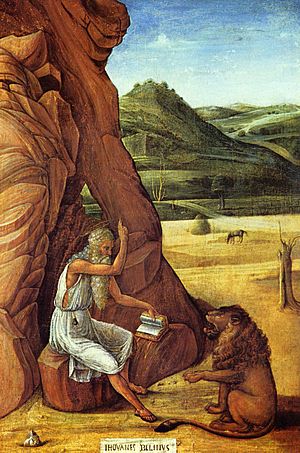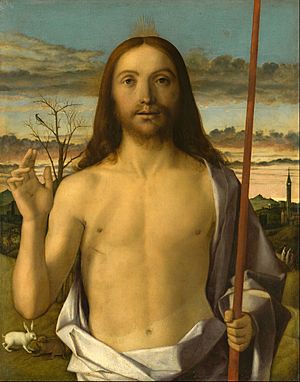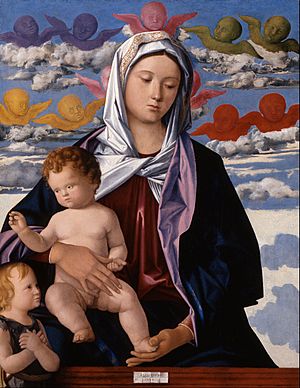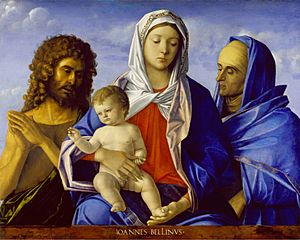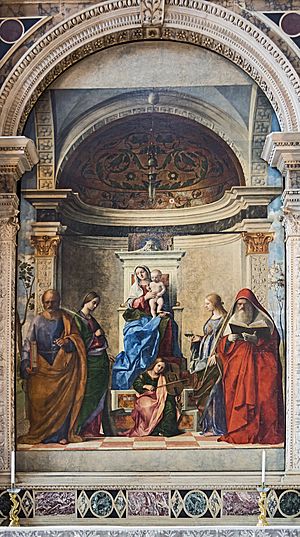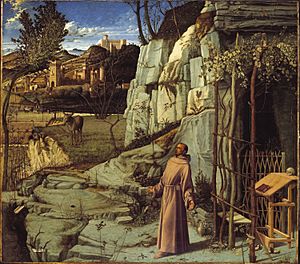Giovanni Bellini facts for kids
Quick facts for kids
Giovanni Bellini
|
|
|---|---|
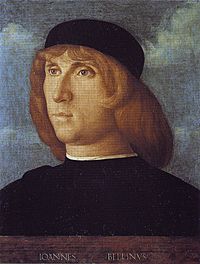
|
|
| Born | c. 1430 |
| Died | 29 December 1516 |
| Nationality | Venetian |
| Known for | Painting |
| Movement | Venetian Renaissance |
Giovanni Bellini (born around 1430 – died November 29, 1516) was a famous Italian Renaissance painter. He is likely the best-known artist from the Bellini family of Venetian painters. He grew up in the home of Jacopo Bellini, who was once thought to be his father but is now believed to have been his much older brother. Giovanni's older brother, Gentile Bellini, was more famous during his lifetime, but today Giovanni is considered the greater artist. His brother-in-law was also a well-known painter, Andrea Mantegna.
Giovanni Bellini changed Venetian painting forever. He made it more colorful and emotional. He used clear, slow-drying oil paints to create deep, rich colors and detailed shadows. His beautiful colors and realistic landscapes greatly influenced other Venetian painters, especially his students Giorgione and Titian.
Contents
Giovanni Bellini's Life
Early Painting Years
Giovanni Bellini was born in Venice, a city in Italy. He was raised in the home of Jacopo Bellini, who was also a painter. Giovanni worked closely with his older brother, Gentile, throughout his life. In his early works, Giovanni showed deep religious feelings and human emotions.
His first paintings were made using the old tempera method. Tempera paint is made by mixing colored powders with egg yolk. This gave his early scenes a soft, romantic glow, like in his painting St. Jerome in the Desert.
Giovanni also painted many scenes of the Dead Christ, also known as Pietà. These paintings showed less harsh lines and softer shapes. His early art often looked similar to the works of his brother-in-law, Andrea Mantegna.
Around 1470, Giovanni started working on bigger projects. He was asked to paint a scene called Deluge with Noah's Ark for a public building in Venice. Sadly, many of his large public paintings from this time, including those for churches and the Duke's palace, have been lost over the years.
Developing His Style
After 1470, Giovanni's skills grew even more. He painted the Transfiguration, which is now in a museum in Naples. This painting showed his improved abilities and a calmer feeling.
Another important work from this time is the large altar-piece called Coronation of the Virgin in Pesaro. This was one of his first big altar paintings, a type of art often done by other painters in Venice.
Many of Giovanni's large public artworks, like those of his brother Gentile, are now gone. For example, a famous altar-piece he painted for a church in Venice was destroyed in a big fire in 1867.
After 1479, Giovanni spent a lot of time working at the Doge's Palace. This was a very important job. He was paid well to fix and update old paintings and create new ones. These new paintings showed Venice's role in historical wars. These works were greatly admired, but they were also lost in a fire in 1577.
Luckily, many of his religious paintings, including altar-pieces and simple Madonnas, have survived. These show how he slowly moved away from older painting styles. He also became a master of the new oil painting technique. This technique was brought to Venice by Antonello da Messina around 1473. Oil paints allowed him to blend colors perfectly and create amazing light effects.
His paintings began to show a calm and charming feeling instead of intense religious emotion. His Virgin and Child paintings became sweet and powerful. The saints in his art looked strong and unique. He often added groups of angels playing music, which added to the peaceful feeling of the scenes. The rich colors of Venice filled his figures, buildings, landscapes, and skies.
Later Masterpieces
Giovanni's later works, like the San Giobbe Altarpiece and the San Zaccaria Altarpiece, are very similar in style. Both show the Madonna (Mary) and Saints in a "Holy Conversation." The Madonna sits on a throne between classic-looking columns. The holy figures are placed under a golden, mosaic-like dome, similar to the St. Mark's church in Venice.
In the San Zaccaria painting, Bellini painted the Virgin Mary surrounded by saints. These include St. Peter with his keys, St. Catherine and St. Lucy holding their symbols of martyrdom, and St. Jerome with a book.
The lighting in the San Zaccaria painting is very soft and spread out. This shows how much Giovanni had improved his use of oil paint. The holy figures seem to be in a calm, special atmosphere. The San Zaccaria is considered one of his most beautiful altar-pieces. It was painted in 1505.
Other important late altar-pieces include one for the church of San Francesco della Vigna (1507) and a Baptism of Christ (1510).
Giovanni was very busy in his last years, with more painting requests than he could finish. Even famous artists like Albrecht Dürer visited Venice in 1506 and called Giovanni Bellini the best painter in the city. Dürer also said Bellini was very kind to other artists.
In 1507, Giovanni's brother Gentile died. Giovanni finished a painting called Preaching of St. Mark that Gentile had left unfinished.
Later, around 1513, Giovanni's student Titian wanted to share his important painting job at the Doge's Palace. This caused some trouble for the older master. In 1514, Giovanni started painting The Feast of the Gods for a duke, but he died in 1516 before finishing it. His student Titian completed it later.
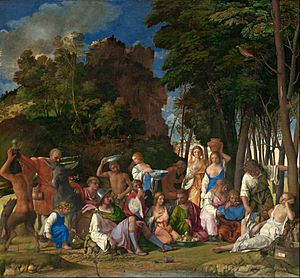
Giovanni Bellini died on November 29, 1516, and was buried in a church in Venice.
Bellini's Impact on Art
Giovanni Bellini had a very successful career, both artistically and in terms of fame. He started painting in the older Quattrocento style (from the 1400s). But he grew and developed his art into the newer Renaissance styles. He saw his own painting school become much more famous than his rivals. He showed the deep religious feelings and the worldly beauty of Venice in his art.
His influence spread through many students. Two of them, Giorgione and Titian, became as famous as or even more famous than their teacher. Bellini lived five years longer than Giorgione. Titian, as we saw, even challenged his teacher for important painting jobs. Other students from Bellini's studio included Girolamo Galizzi da Santacroce and Andrea Previtali.
Bellini was very important for the development of the Italian Renaissance. He brought ideas from Northern European art into his work. He was greatly influenced by Antonello da Messina and the new trend of oil painting. Bellini introduced the "pala" (single-panel altar-piece) to Venice with his work Coronation of the Virgin. This painting was like a "window" to a natural scene, making it easier for viewers to connect with the art.
He also used "disguised symbolism," where everyday objects in a painting have a hidden religious meaning. Bellini mastered Antonello's oil painting style and surface textures. He used these skills to create a unique Venetian way of painting. He combined this new technique with the traditional Venetian and Byzantine styles of using images and colors. This created a spiritual feeling not found in other artists' works. The realism of oil painting mixed with Venice's religious traditions made Bellini's style unique. This made him one of the most creative painters of the Venetian Renaissance.
In paintings like St. Francis in Ecstasy (around 1480) and the San Giobbe Altarpiece (around 1478), Bellini used natural things like grapevines and rocks to add religious symbols. But his biggest contribution to art was how he experimented with color and atmosphere in oil painting.
The Bellini cocktail is a drink named in his honor!
Spanish museums have a few, but very high-quality, examples of his work. The Prado Museum has a Virgin and Child between two Saints. The Thyssen-Bornemisza Museum has a Nunc Dimittis, and the Real Academia de Bellas Artes de San Fernando holds a Saviour.
Images for kids
 In Spanish: Giovanni Bellini para niños
In Spanish: Giovanni Bellini para niños


